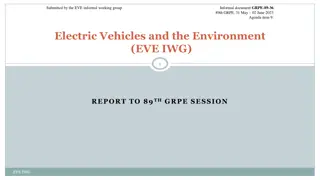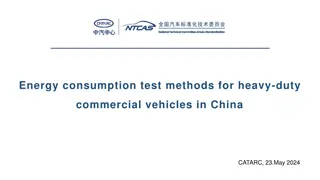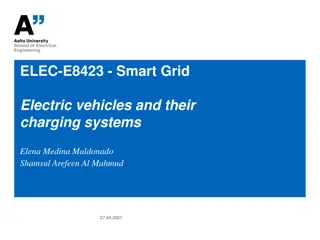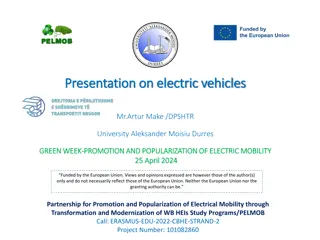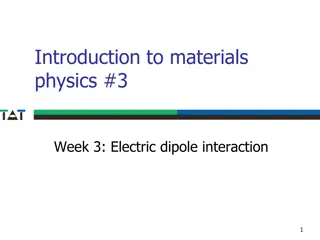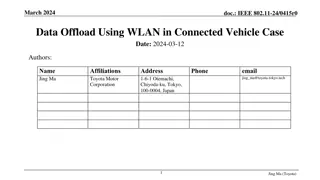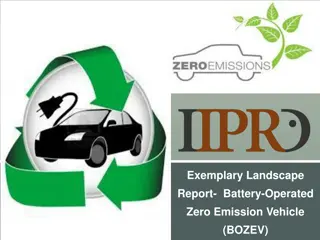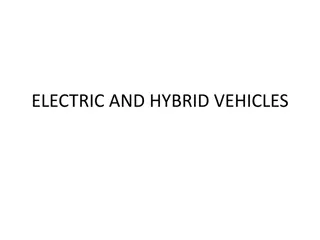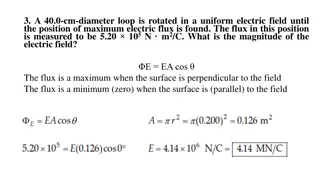
How do Electric Vehicles work?
The Intergovernmental Panel on Climate Change (IPCC) plays a crucial role in assessing climate science, highlighting future climate impacts, and offering solutions. Their latest report emphasizes the urgent need to address human-induced warming and outlines key strategies for achieving net-zero carbon emissions by 2050. Learn about electric vehicles, greenhouse gas reduction, and the importance of immediate action to combat climate change.
Download Presentation

Please find below an Image/Link to download the presentation.
The content on the website is provided AS IS for your information and personal use only. It may not be sold, licensed, or shared on other websites without obtaining consent from the author. If you encounter any issues during the download, it is possible that the publisher has removed the file from their server.
You are allowed to download the files provided on this website for personal or commercial use, subject to the condition that they are used lawfully. All files are the property of their respective owners.
The content on the website is provided AS IS for your information and personal use only. It may not be sold, licensed, or shared on other websites without obtaining consent from the author.
E N D
Presentation Transcript
IPCC Climate Change Solutions How do Electric Vehicles work?
Learning intentions: Students will... ... demonstrate ways in which net-zero carbon emissions can be reached by 2050. Success criteria: Students can explain, with diagrams and technical language, how electric cars work explain, with evidence, how such cars reduce carbon emissions.
The Intergovernmental Panel on Climate Change (IPCC) is the United Nations body for assessing the science related to climate change. It was created to provide policymakers (governments) with regular scientific updates about climate change; highlight the impact climate change will have on the planet in the future; and, offer some ideas about how to tackle the challenges of climate change's potential effects on the planet. In 2021-22, the IPCC released Part 1 of the Sixth Assessment Report. This is the most up-to-date physical understanding of the climate system and climate change.
The report makes a number of important points: It is unequivocal that human influence has warmed the atmosphere, ocean and land (A1). What does the word unequivocal mean? Global surface temperature will continue to increase until at least mid-century under all emissions scenarios considered. Global warming of 1.5 C and 2 C will be exceeded during the 21st century unless deep reductions in CO2 and other greenhouse gas emissions occur in the coming decades (B1). The report describes five possible climate futures, where #1 is not great and #5 is extremely bad. If we want to keep global warming at less than two degrees, which the IPCC says is the best-case scenario, we need to reduce our C02 and greenhouse gas emissions significantly and start right away.
'Net zero' or 'carbon neutral' are terms that refer to achieving an overall balance between greenhouse gas emissions produced and greenhouse gas emissions taken out of the atmosphere. Getting to net zero means we can still produce some emissions, so long as we're doing something else to reduce the greenhouse gases already in the atmosphere at the same time, kind of like balancing a set of scales (more info).
Currently, 8 gigatonnes of total annual carbon emissions are emissions from our transportation. If, by 2040, 50% of the kilometres driven (2-wheelers, 3-wheelers, cars, buses, and trucks) on the world s roads are electric, and by 2050 95% are electric, this alone will reduce these emissions by 5Gt (Source).
On the basis of recent studies, the total life cycle emissions from a fossil-fuelled car in Australia were about 333g of CO per km. For an electric car, emissions were 273g of CO per km This means EVs are 18% better in terms of their carbon footprint. (In New Zealand, life-cycle emissions for fossil-fuelled cars were at about 333 g of CO per km for fossil-fuelled cars and 128g of CO per km for electric cars, making EVs 62% better than fossil cars in carbon footprint terms.)
How Car Engine Works | Autotechlabs Have you ever wondered how a car engine works ?. Well, here it is...Autotechlabs brings you another presentation on how a car engine works.The video explains the internal structure of a four cylinder engine and also the working of a four stroke engine. Watch,Learn Don't forget to Like and Subscribe.
How Do Electric Vehicles Work? Ever wondered how EVs get from A to B? Is it essentially the same as an internal combustion car, but wired up to a giant battery? Or is there some altogether more subtle trickery afoot? SUGGEST A TOPIC https://techvision.tv Imagery supplied via Getty Images
YOUR CHALLENGE create a labelled diagram describing how engines work in electric vehicles, and how they differ from combustion engines. Write objectively about the benefits, and challenges, involved in adopting electric vehicles. Remember: Learning intentions: Students will... ... demonstrate ways in which net-zero carbon emissions can be reached by 2050. Success criteria: Students can explain, with diagrams and technical language, how electric cars work explain, with evidence, how such cars reduce carbon emissions. How do electric vehicles help us reach net-zero carbon emissions by 2050. How do electric vehicles NOT help us reach this goal.
Reflection "Australia s electric car revolution won t happen automatically". Do you think electric vehicles are a legitimate replacement for combustion engines? Are they overwhelmingly beneficial? Do they come with too many complications and challenges? Or is the answer somewhere in the middle?


